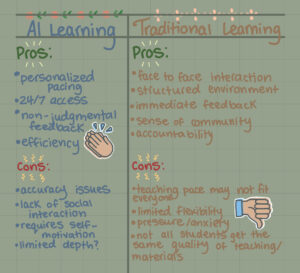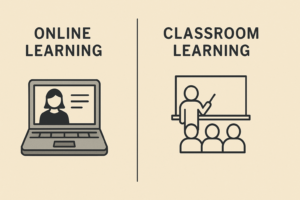Starting point:
This project sparked my interest, as it ties in psychology, education and technology. We questioned whether AI open learning is more adaptive to individual needs vs. Traditional learning roles (in-person classrooms). As AI continues to be introduced in classrooms, we wanted to see how well and reliable it can be for students. According to studies, AI systems can bridge learning gaps by customizing info that fits a learners pace, skills, and/or preferences. We made a commitment to write weekly blogs that revolved around experimenting with AI tools, reading some articles and doing some reflections.
Quizlets AI summary:
I decided to look into Quizlet and new addition of AI. I’ve been using this learning app to make flashcards but never used the AI component until this course. I uploaded some of my notes from my previous PSYC class and used the “Practice Test” tool to see how helpful it really is.
There was a notice that read “This product is enhanced by AI and may provide incorrect or problematic content”. I noticed that some of the questions it generated wasn’t totally aligned with my notes or fully correct. Emilia David (2023) wrote about a similar experience using Quizlet’s AI. This supported my suspicions and served as a reminder that even though AI is very helpful, it cannot always take the place of human reasoning, accuracy and learning/original content.
AI learning vs. Traditional roles:
Throughout this topic, there was a lot that I thought about when it comes to AI-based learning and traditional roles in learning. Traditional learning has been integrated into our lives for thousands of years, whereas AI learning is very fresh. Learning in a physical classroom can offer structure and human connection, however it doesn’t really permit flexibility or individualized pace. Whereas AI learning allows you to learn at your own speed. You can skip forward, go over a subject more than once, and it’s quick! Students who may need additional time in their works might find AI learning to be a benefit. Avinash Chander (2025) recognizes the benefits and limitations of traditional learning and AI learning, and dives deeply into human interaction and emotional support. That being, traditional classrooms foster student relationships and trust, and AI is accessible and excessible at anytime.

EDCI pros and cons AI traditional
These distinctions made it clear to me that AI isn’t better or worse than traditional learning its just a little different! AI offers flexibility but isn’t always reliable, whereas traditional learning provides structure and clarify but might come across inflexible for some
Final thoughts:
Overall, I still acknowledge that the structure of traditional learning benefits me. I find being in a physical classroom provides me with routine and holds me accountable, including that I’m more motivated to connect with the content because of the real-time engagement. Although, i do like the freedom of AI learning, I’ve found that having to much autonomy might make it more simple to put things off or overlook information. I find the most successful strategy is balance AI as a sort of addition, while still relying on traditional learning.
Refrences:
https://www.linkedin.com/pulse/ai-powered-vs-traditional-education-whats-future-learning-chander-0d3ic#:~:text=Rather%20than%20choosing%20between%20AI,provide%20emotional%20support%20and%20clarification.
https://www.pearson.com/content/dam/one-dot-com/one-dot-com/global/Files/about-pearson/innovation/open-ideas/Intelligence-Unleashed-Publication.pdf
https://www.forbes.com/sites/rayravaglia/2023/08/10/quizlet-embraces-ai-and-chatgpt-to-transform-the-experience-of-studying/
